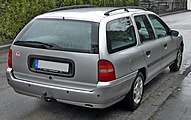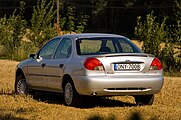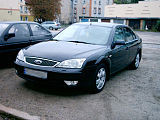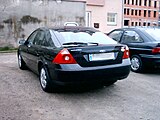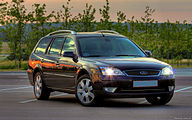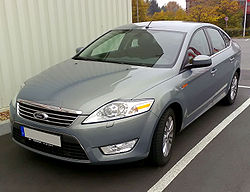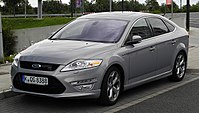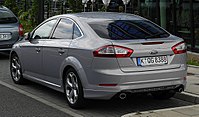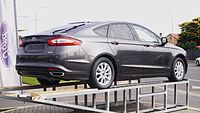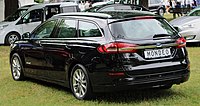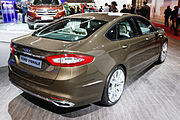Ford Mondeo
| Ford Mondeo | |
|---|---|
| Production period: | Since 1993 |
| Class : | Middle class |
| Body versions : | Sedan , hatchback , station wagon |
| Previous model: | Ford Sierra |
The Ford Mondeo is a passenger car model of the car manufacturer Ford in the middle class . The largely identical Ford Fusion is offered on the American market . Since September 2019 it has been known that Ford is phasing out the Mondeo and is concentrating more on the SUV sector.
Model history
The Mondeo is the successor to the Ford Sierra presented in the late summer of 1982 . With the first series produced from the beginning of 1993 to late summer 2000, Ford pursued the idea of a “world car”. Mundus means world in the Latin language. With largely the same technology, the design language and the naming of the Ford Mondeo, built for Europe in Belgium, differed from the vehicles built in the USA with the name Mercury Mystique and Ford Contour .
The Ford Mondeo was also voted Car of the Year 1994. From 1994 to 2000 Ford offered all three body styles ( notchback , hatchback and the Kombi called the tournament ) at the same price. In the summer of 1996, the appearance of the European Mondeo and the US models was largely standardized. In autumn 2000 the shape was changed away from the “Cab-Forward-Design” (see below) to the New-Edge-Design . At the beginning of 2007, the new "kinetic design" concept by Martin Smith was implemented for the current Mondeo. From late summer 2013, the fourth generation should middle-class vehicle offered, and here again a combined tournament and a sedan is offered with step or hatchback. However, due to the closure of the Ford plant in Genk , the market launch was postponed to the beginning of 2015.
The vehicles were built from the beginning of 1993 in Genk, Belgium, in a branch of the German Ford-Werke GmbH . Since the Ford plant in Genk was closed in the summer of 2014, the vehicles have been produced in the Ford plant in Almussafes near Valencia ( Spain ) and, since April 2015, in Vsevoloschsk near Saint Petersburg ( Russia ).
In 2018, Ford announced that it would phase out all sedans in the USA without a successor. The model range should consist of 90% SUVs and pick-ups. This also applies to the Ford Fusion in the USA. But Ford stated that the Mondeo (sedan and tournament) is one of the most important models in Europe and that there will be a successor.
Mondeo '93 (type GBP / BNP, 1993–1996)
| 1st generation | |
|---|---|
|
Ford Mondeo hatchback (1993-1996) |
|
| Production period: | 1993-1996 |
| Body versions : | Sedan , hatchback , station wagon |
| Engines: |
Otto engines : 1.6–2.5 liters (65–125 kW) Diesel engine : 1.8 liters (65–66 kW) |
| Length: | 4481-4631 mm |
| Width: | 1749 mm |
| Height: | 1428-1442 mm |
| Wheelbase : | 2704 mm |
| Empty weight : | 1215-1350 kg |
With the introduction of the Mondeo on March 4, 1993, Ford returned to front-wheel drive in the middle class after 22 years . However, the Mondeo was also available for a short time in conjunction with the 2.0-liter four-wheel drive engine. The car was initially offered with three four-cylinder 16V petrol engines (" Zetec " engine generation) and a diesel engine. The Duratec V6 engine with 125 kW followed in mid-1994 . The goal for the Mondeo: 15% market share in the middle class defined by Ford as the "C / D segment". The vehicle equipment ranged from the basic CLX model to the GLX model with a little more equipment to the top version Ghia. At times there were some special models (for example Festival, Fashion, Skylight). If you add all-wheel and automatic versions, a total of 40 variants of the Mondeo could be put together as early as 1993.
The design of the Mondeo was already fixed in 1986. One of the most important points in the Ford newcomer's specifications was: “Larger interior space with unchanged compact exterior dimensions.” That meant saying goodbye to the rear-wheel drive of the Sierra and a body in the style-defining Cab-Forward design. This planned to cut the space for the technology as much as possible in order to allow the passenger cell to start further ahead. The Mondeo began with a distinctly low bonnet, which was 20 cm shorter than that of the Sierra because of the transverse engine. While the length remained roughly the same, the wheelbase grew by 10 cm and the width by 5 cm. The 34 mm larger adjustment range of the front seats and the 20 mm increased headroom at the front offered the occupants more space. In order to give the Mondeo a slim appearance, the Ford designers chose a low-set and gently rising bonnet, large, flush-mounted windows and narrow roof pillars. The barely noticeable rising sideline made the rear end appear delicate.
In order to achieve as deep and wide a cargo space as possible during the tournament, an elaborate rear suspension was developed. It essentially consisted of three wishbones and a trailing arm . Their articulation points, mounted far to the outside and deep, together with separate springs and dampers, enabled a large cargo space. In addition, the Mondeo can be driven very agile with this multi-link rear axle . This Mondeo decelerated with ventilated brake discs at the front and 229 mm drum brakes at the rear. The all-wheel drive and V6 models were equipped with massive brake discs at the rear. The new 16V and 24V petrol engines in the Mondeo '93 were among the most modern in mid-range vehicles at the time. The chassis, which was tuned with the help of ex-racing driver Jackie Stewart , was also considered exemplary. The body shape was criticized in parts of the trade press as being too cautious and was thoroughly corrected in autumn 1996. Another focus of the development work was the reduction of unwanted noise and vibrations ( NVH ).
Technical specifications
| 1.6 | 1.8 | 2.0 | 2.5 | 1.8 TD | ||||
|---|---|---|---|---|---|---|---|---|
| Construction period | 01 / 1993-06 / 1994 | 07 / 1994-08 / 1996 | 01 / 1993-06 / 1994 | 07 / 1994-08 / 1996 | 01 / 1993-08 / 1996 | 07 / 1994-08 / 1996 | 06 / 1993-08 / 1996 | |
| Engine characteristics | ||||||||
| Engine identification | L1F | L1J | RKA | RKB | NGA | SEA | RFN, RFM | RFD, RFK |
| Engine type | Zetec (R4 petrol engine) | Duratec (V6 petrol engine) | Endura-D (R4 diesel engine) | |||||
| Number of valves per cylinder | 4th | 2 | ||||||
| Valve control | DOHC , timing belt | 2 × DOHC, chain | OHC, timing belt | |||||
| Mixture preparation | Manifold injection |
Swirl chamber injection |
||||||
| Engine charging | - |
Turbocharger , intercooler |
||||||
| cooling | Water cooling | |||||||
| Bore × stroke | 76.0 mm × 88.0 mm | 80.6 mm × 88.0 mm | 84.8 mm x 88.0 mm | 82.4 mm × 79.5 mm | 82.5 mm × 82.0 mm | |||
| Displacement | 1597 cc | 1796 cc | 1988 cc | 2544 cc | 1753 cc | |||
| Compression ratio | 10.3: 1 | 10.0: 1 | 9.7: 1 | 21.5: 1 | ||||
| Max. power | 66 kW (90 PS) at 5250 rpm |
65 kW (88 PS) at 5250 rpm |
85 kW (115 PS) at 5750 rpm |
82 kW (112 hp) at 5750 rpm |
100 kW (136 PS) at 6000 rpm |
125 kW (170 PS) at 6250 rpm |
65 kW (88 PS) at 4500 rpm |
66 kW (90 PS) at 4500 rpm |
| Max. Torque | 138 Nm at 3500 rpm |
158 Nm at 3750 rpm |
180 Nm at 4000 rpm |
220 Nm at 4250 rpm |
178 Nm at 2000 rpm |
180 Nm at 2000 rpm |
||
| Power transmission | ||||||||
| Drive, as standard | Front wheel drive | |||||||
| Drive, optional | - | all wheel drive | - | |||||
| Gearbox, as standard | 5-speed manual transmission | |||||||
| Gearbox, optional | - | 4- speed automatic transmission | - | |||||
| Measured values (limousine) | ||||||||
| Top speed | 180 km / h | 195 km / h (179 km / h) |
209 km / h (194 km / h) [203 km / h] |
225 km / h (210 km / h) |
181 km / h | |||
| Acceleration, 0-100 km / h | 13.7 s | 11.1 s (13.8 s) |
9.7 s (11.9 s) |
8.6 s (10.4 s) |
13.7 s | |||
| Fuel consumption over 100 km (combined) | 7.1 l p | 6.8 l S (7.5 l S) |
7.5 l S (7.7 l S) [8.4 l S] |
8.2 l p | 6.4 l D | |||
| Measured values (combi) | ||||||||
| Top speed | 175 km / h | 190 km / h (174 km / h) |
199 km / h (189 km / h) [198 km / h] |
215 km / h (200 km / h) |
176 km / h | |||
| Acceleration, 0-100 km / h | 13.9 s | 11.4 s (14.1 s) |
9.9 s (12.1 s) |
8.7 s (10.4 s) |
14.1 s | |||
| Fuel consumption over 100 km (combined) | 7.9 l p | 7.7 l p | 7.4 l S (8.3 l S) |
8.4 l S (8.3 l S) [8.7 l S] |
9.0 l S | 7.1 l D | ||
- ↑ 2.0 4 × 4: 97 kW (132 PS)
- ↑ 2.0: With modified air intake in Austria until EU accession and Switzerland also as Mondeo RS with 105 kW (143 PS)
- ↑ a b Values in () for automatic transmission and in [] for all-wheel drive.
- The availability of the engines depended on the model, equipment and market.
Mondeo '97 (type BAP / BFP / BNP, 1996-2000)
| 2nd generation | |
|---|---|
|
Ford Mondeo Hatchback (1996-2000) |
|
| Production period: | 1996-2000 |
| Body versions : | Sedan , hatchback , station wagon |
| Engines: |
Otto engines : 1.6–2.5 liters (65–151 kW) Diesel engine : 1.8 liters (66 kW) |
| Length: | 4556-4671 mm |
| Width: | 1751 mm |
| Height: | 1380-1450 mm |
| Wheelbase : | 2704 mm |
| Empty weight : | 1293-1616 kg |
| Stars in the Euro NCAP - Crash Test (1997): |
|
In August 1996 the Mondeo underwent a major overhaul, with sales starting in November 1996. Although it is only a heavily modified version of the first generation, the Mondeo '97 is a second series at Ford. The radiator grille was redesigned and given the shape of an ellipse, the headlights were curved more strongly and raised further. These modifications were associated with structural changes, which is why new crash tests were necessary. The technology and the engines were largely taken over unchanged from the predecessor. The Mondeo '97 decelerated at the front with internally ventilated brake discs and at the rear, depending on the vehicle equipment, with brake drums, internally or externally ventilated brake discs. From May 1998 there was the Mondeo with higher quality materials in the interior and slight technical changes, including the exhaust system. The equipment variants were initially taken from the original model, later new names were introduced:
- Ambience (basic equipment)
- Trend (plus some useful extras)
- Festival (special model)
- Futura (special model)
- Ghia ("luxury version")
The Mondeo '97 also featured more special models than before. From autumn 1999 there was a sport version of the 2.5-liter Duratec V6 engine Mondeo ST 200 with 151 kW.
Technical specifications
| 1.6 | 1.8 | 2.0 | 2.5 | 2.5 ST200 | 1.8 TD | ||||
|---|---|---|---|---|---|---|---|---|---|
| Construction period | 08 / 1996-04 / 1999 | 05 / 1999-10 / 2000 | 08 / 1996-10 / 2000 | 08 / 1996-05 / 1998 | 05 / 1998-10 / 2000 | 08 / 1996-04 / 1999 | 05 / 1999-10 / 2000 | 08 / 1996-10 / 2000 | |
| Engine characteristics | |||||||||
| Engine identification | L1J | L1L, L1N | RKB, RFK | NGA | NGB | SEA | SEB | SGA | RFN |
| Engine type | Zetec (R4 petrol engine) | Duratec (V6 petrol engine) | Endura-D (R4 diesel engine) | ||||||
| Number of valves per cylinder | 4th | 2 | |||||||
| Valve control | DOHC , timing belt | 2 × DOHC, chain | OHC, timing belt | ||||||
| Mixture preparation | Manifold injection |
Swirl chamber injection |
|||||||
| Engine charging | - |
Turbocharger , intercooler |
|||||||
| cooling | Water cooling | ||||||||
| Bore × stroke | 76.0 mm × 88.0 mm | 80.6 mm × 88.0 mm | 84.8 mm x 88.0 mm | 82.4 mm × 79.5 mm | 81.6 mm × 79.5 mm | 82.5 mm × 82.0 mm | |||
| Displacement | 1597 cc | 1796 cc | 1988 cc | 2544 cc | 2495 cc | 1753 cc | |||
| Compression ratio | 10.3: 1 | 10.0: 1 | 9.7: 1 | 10.25: 1 | 21.5: 1 | ||||
| Max. power | 66 kW (90 PS) at 5250 rpm |
70 kW (95 PS) at 5250 rpm |
85 kW (116 hp) at 5750 rpm |
96 kW (131 PS) at 5700 rpm |
96 kW (131 PS) at 5600 rpm |
125 kW (170 PS) at 6250 rpm |
151 kW (205 PS) at 6500 rpm |
66 kW (90 PS) at 4500 rpm |
|
| Max. Torque | 138 Nm at 3500 rpm |
142 Nm at 3600 rpm |
158 Nm at 3750 rpm |
176 Nm at 3700 rpm |
178 Nm at 4000 rpm |
220 Nm at 4250 rpm |
235 Nm at 5500 rpm |
177 Nm at 2250 rpm |
|
| Power transmission | |||||||||
| drive | Front wheel drive | ||||||||
| Gearbox, as standard | 5-speed manual transmission | ||||||||
| Gearbox, optional | - | 4- speed automatic transmission | - | ||||||
| Measured values (limousine) | |||||||||
| Top speed | 180 km / h | 185 km / h | 195 km / h (179 km / h) |
206 km / h (190 km / h) |
224 km / h (210 km / h) |
231 km / h | 180 km / h | ||
| Acceleration, 0-100 km / h | 13.4-13.8 s | 13.1 s | 11.0 s (13.4 s) |
9.9 s (11.7 s) |
10.0 s (11.7 s) |
8.3 s (10.5 s) |
8.3 s (10.0 s) |
7.7 s | 13.9 s |
| Fuel consumption over 100 km (combined) | 7.1-7.7 s | 7.6-8.3 S. | 7.3–8.4 l S (8.8–9.4 l S) |
8.1–8.7 l S (8.8–9.5 l S) |
8.0–8.9 l S (8.7–9.6 l S) |
9.0–9.7 l S (10.1–10.3 l S) |
9.2–9.5 l S (9.7–10.1 l S) |
10.1 l p | 6.0-6.6 lD |
| CO 2 emissions (combined) | 170-196 g / km | 182-199 g / km | 178–202 g / km (211–227 g / km) |
194–210 g / km (212–227 g / km) |
192–213 g / km (205–229 g / km) |
215–233 g / km (242–247 g / km) |
219–228 g / km (231–247 g / km) |
242 g / km | 161-178 g / km |
| Measured values (combi) | |||||||||
| Top speed | 175 km / h | 180 km / h | 190 km / h (174 km / h) |
199 km / h (186 km / h) |
215 km / h (200 km / h) |
227 km / h | 176 km / h | ||
| Acceleration, 0-100 km / h | 13.9-14.3 s | 13.5 s | 11.4 s (13.9 s) |
10.3 s (12.2 s) |
10.2 s (12.1 s) |
8.6 s (11.0 s) |
8.5 s (10.3 s) |
7.8 s | 14.0 s |
| Fuel consumption over 100 km (combined) | 7.6-8.5 l S | 7.8-8.5 s | 8.0–8.7 l S (9.4–10.0 l S) |
8.4–9.1 l S (9.4–9.9 l S) |
8.2–9.1 l S (9.2–10.2 l S) |
9.2-10.0 L S (10.3-10.5 L S) |
9.3–9.8 l S (9.8–10.5 l S) |
10.4 l S | 6.3-6.8 I. D. |
| CO 2 emissions (combined) | 182-203 g / km | 187-204 g / km | 191–209 g / km (225–239 g / km) |
202–219 g / km (227–238 g / km) |
196–218 g / km (218–241 g / km) |
220–240 g / km (246–253 g / km) |
223–235 g / km (235–251 g / km) |
249 g / km | 170-183 g / km |
- ↑ 1.6 66 kW (90 PS): For some export countries 65 kW (88 PS)
- ↑ 1.6 70 kW (95 PS): For some export countries 66 kW (90 PS)
- ↑ a b Values in () for automatic transmissions.
- The availability of the engines depended on the model, equipment and market.
Mondeo '01 (type B4Y / B5Y / BWY, 2000–2007)
| 3rd generation | |
|---|---|
|
Ford Mondeo Tournament (2000-2003) |
|
| Production period: | 2000–2007 (under license until 2009) |
| Body versions : | Sedan , hatchback , station wagon |
| Engines: |
Otto engines : 1.8–3.0 liters (81–166 kW) Diesel engines : 2.0–2.2 liters (66–114 kW) |
| Length: | 4756-4833 mm |
| Width: | 1812 mm |
| Height: | 1459-1514 mm |
| Wheelbase : | 2754 mm |
| Empty weight : | 1369-1616 kg |
The third generation Mondeo was completely redeveloped and was manufactured from October 2000. With the support of the new head of design in the Ford Group, J Mays , the New Edge design was defused and further developed. At the time of its market launch, the chassis of the Mondeo was regarded as the reference in the class of front-wheel-drive mid-range vehicles. Due to its chassis qualities, the smoothness and processing quality, the Mondeo was able to win many comparison tests in the trade press.
| Stars in the Euro NCAP - Crash Test (2001): |
|
| Stars in the Euro NCAP - Crash Test (2002): |
|
The platform of the Mondeo '01 was also the basis for other models within the Ford Group, some of which came onto the market immediately before the Mondeo. The floor pan of the Mazda6 and the Jaguar X-Type is closely related to that of the Mondeo. The same engines were used in some of the models. Three body versions were also offered for this model: notchback , hatchback and tournament (station wagon) The tournament was the best-selling variant in Germany. The top model was the sport variant ST220 with a 3.0-liter V6 engine that developed 166 kW. Comprehensive safety equipment was standard on the Mondeo, including front, head and side airbags as well as the Intelligent Protection System (IPS) with seat position sensors and active headrests. Air conditioning and disc brakes were also standard, and Ford gave a 12-year guarantee against rust perforation.
The vehicles were delivered in the following equipment series:
- Ambience
- trend
- Futura
- Ghia
- Titanium (from 2005)
- Ghia X (from 2004)
- Titanium X (from 2005)
- Futura X (from 2006)
- ST220
There were also the special models Viva (2004) and Viva X (2005).
Facelift
The first extensive facelift was carried out in June 2003. More than 1500 parts were changed outside, inside and in the engine. The radiator grille and the lower window line got chrome frames, the fog lights were now trapezoidal and the side indicators were white. The rear lights and exterior mirrors have also been redesigned. Higher quality materials were used in the interior and the dashboard was revised, plus there was improved noise and drive comfort. The most powerful TDDi engine available until then was replaced by two new TDCi engines. In September 2004, two new engines were added with a 150 kW three-liter V6 petrol engine and the 114 kW 2.2-liter diesel engine.
There were other minor changes in September 2005 to the front and rear with slightly changed taillights, clear glass side indicators and reflectors near the bottom of the bumpers. From January 2006 there was a soot particle filter as standard in the 2.0-liter diesel engines . In Europe, due to the model change, production of the Mondeo '01 was discontinued in March 2007, in Vietnam only towards the end of 2009.
Technical specifications
Petrol engines
| 1.8 |
1.8 SCi |
2.0 | 2.5 | 3.0 |
ST220 |
||
|---|---|---|---|---|---|---|---|
| Construction period | 10 / 2000-03 / 2007 | 06 / 2003–03 / 2007 | 10 / 2000-03 / 2007 | 09/2004 - 03/2007 | 03 / 2002–03 / 2007 | ||
| Engine characteristics | |||||||
| Engine series | Duratec | Duratec-SCi | Duratec | Duratec V6 | |||
| Engine identification | CGBA, CGBB | CHBA, CHBB | CFBA | CJBA, CJBB | LCBD | REBA | MEBA |
| Engine type | Duratec-HE (R4 petrol engine) | Duratec V6 (V6 petrol engine) | |||||
| Number of valves per cylinder | 4th | ||||||
| Valve control | DOHC , chain | 2 × DOHC, chain | |||||
| Mixture preparation | Manifold injection |
Direct petrol injection |
Manifold injection | ||||
| Engine charging | - | ||||||
| cooling | Water cooling | ||||||
| Bore × stroke | 83.0 mm × 83.1 mm | 87.5 mm x 83.1 mm | 81.6 mm × 79.5 mm | 89.0 mm × 79.5 mm | |||
| Displacement | 1798 cc | 1999 cc | 2495 cc | 2967 cc | |||
| Compression ratio | 10.8: 1 | 11.3: 1 | 10.8: 1 | 9.8: 1 | 10.0: 1 | ||
| Max. power | 81 kW (110 PS) at 5500 rpm |
92 kW (125 PS) at 6000 rpm |
96 kW (130 PS) at 6000 rpm |
107 kW (145 PS) at 6000 rpm |
125 kW (170 PS) at 6000 rpm |
150 kW (204 hp) at 6000 rpm |
166 kW (226 hp) at 6150 rpm |
| Max. Torque | 165 Nm at 3950 rpm |
170 Nm at 4500 rpm |
175 Nm at 4250 rpm |
190 Nm at 4500 rpm |
220 Nm at 4250 rpm |
263 Nm at 4900 rpm |
280 Nm at 4900 rpm |
| Power transmission | |||||||
| drive | Front wheel drive | ||||||
| Gearbox, as standard | 5-speed manual transmission | 6-speed manual transmission | 5-speed manual transmission | 6-speed manual transmission | 5-speed manual transmission |
||
| Gearbox, optionally | - | 4- speed automatic transmission | 6-speed manual or 5-speed automatic transmission |
- | |||
| Measured values (limousine) | |||||||
| Top speed | 193 km / h | 205 km / h | 207 km / h | 215 km / h (190 km / h) |
225 km / h (216 km / h) |
240 km / h | 250 km / h |
| Acceleration, 0-100 km / h | 11.6 s | 10.8 s | 10.5 s | 9.8 s (11.4 s) |
8.5 s (10.3 s) |
7.9 s | 7.6 s |
| Fuel consumption over 100 km (combined) | 7.7 l p | 7.8 l S | 7.2 l p | 8.0 l S (9.4 l S) |
10.2 l S | 10.3 l S | 10.4 l S |
| Measured values (combi) | |||||||
| Top speed | 190 km / h | 200 km / h | 202 km / h | 210 km / h (187 km / h) |
220 km / h (211 km / h) |
232 km / h | 241 km / h |
| Acceleration, 0-100 km / h | 12.1 s | 11.2 s | 10.6 s | 10.2 s (11.8 s) |
8.9 s (10.7 s) |
8.1 s | 7.8 s |
| Fuel consumption over 100 km (combined) | 7.9 l p | 8.0 l S | 7.2 l SP | 8.1 L S (9.2 L S) |
10.4 l S (10.5 l S) |
10.5 l S | 10.6 l p |
| Remarks | |||||||
| not for E10 fuel suitable | |||||||
- ↑ The two 1.8 liter engines are mechanically identical; the different performance is achieved exclusively via the motor control software.
- ↑ SCi = S mart C harge I njection
- ↑ a b The two 3.0-liter engines are mechanically the same; the different performance is achieved via the engine control software and different exhaust systems.
- ↑ From June 2003: 285 Nm
- ↑ From June 2003: 6-speed
- ↑ a b Values in () for automatic transmissions
- The availability of the engines depended on the model, equipment and market.
Diesel engines
| 2.0 TDDi |
2.0 TDCi | 2.0 TDDi | 2.0 TDCi |
2.2 TDCi | ||
|---|---|---|---|---|---|---|
| Construction period | 10 / 2000-08 / 2005 | 08/2005–03/2007 | 10 / 2000-03 / 2002 | 03 / 2002–01 / 2006 | 03 / 2002–03 / 2007 | 09/2004 - 03/2007 |
| Engine characteristics | ||||||
| Engine series | Duratorq-Di | Duratorq TDCi | Duratorq-Di | Duratorq TDCi | ||
| Engine identification | D5BA | SDBA | D6BA | HJBA | FMBA, N7BA | QJBA, QJBB |
| Engine type | R4 diesel engine | |||||
| Number of valves per cylinder | 4th | |||||
| Valve control | DOHC , chain | |||||
| Mixture preparation | Diesel direct injection | Common rail injection | Diesel direct injection | Common rail injection | ||
| Engine charging | Turbocharger , intercooler | |||||
| cooling | Water cooling | |||||
| Bore × stroke | 86.0 mm × 86.0 mm | 86.0 mm × 94.0 mm | ||||
| Displacement | 1998 cc | 2198 cc | ||||
| Compression ratio | 19.0: 1 | 19.5: 1 | 19.0: 1 | 18.2: 1 | 17.5: 1 | |
| Max. power | 66 kW (90 PS) at 4000 rpm |
85 kW (116 PS) at 4000 rpm |
96 kW (130 PS) at 3800 rpm |
114 kW (155 PS) at 3500 rpm |
||
| Max. Torque | 245 Nm at 1900 rpm |
280 Nm at 1900 rpm |
330 Nm at 1800 rpm |
360 Nm at 1800 rpm |
||
| Power transmission | ||||||
| drive | Front wheel drive | |||||
| Gearbox, as standard | 5-speed manual transmission | 6-speed manual transmission | ||||
| Gearbox, optional | - | 6-speed manual or 5- speed automatic transmission |
- | |||
| Measured values (limousine) | ||||||
| Top speed | 180 km / h | 195 km / h | 200 km / h (193 km / h) |
208 km / h (200 km / h) |
220 km / h | |
| Acceleration, 0-100 km / h | 13.1 s | 12.8 s | 10.6 s | 10.8 s (12.5 s) |
9.8 s (11.3 s) |
8.9 s |
| Fuel consumption over 100 km (combined) | 5.9 l D | 5.8 l D | 5.9 l D | 5.8 L D (7.4 L D) |
6.0 L D (7.4 L D) |
6.1 l D |
| Measured values (combi) | ||||||
| Top speed | 177 km / h | 193 km / h | 197 km / h (194 km / h) |
204 km / h (197 km / h) |
216 km / h | |
| Acceleration, 0-100 km / h | 13.7 s | 13.4 s | 11.0 s | 11.2 s (13.0 s) |
10.1 s (11.6 s) |
9.2 s |
| Fuel consumption over 100 km (combined) | 5.9 l D | 6.0 l D | 5.9 l D (7.5 l D) |
6.2 L D (7.5 L D) |
6.3 l D | |
- ↑ The two 2.0-liter TDDi engines are mechanically the same; The different power levels are achieved using two different injection pumps, the Bosch VP 30 for the 90 hp engine and the Bosch VP 44 for the 115 hp engine.
- ↑ The two 2.0-liter TDCi engines are mechanically identical; the different performance is achieved exclusively via the motor control software.
- ↑ a b Values in () for automatic transmissions.
- The availability of the engines depended on the model, equipment and market.
Problems
From 2007, owners and automobile magazines repeatedly found an increased susceptibility to rust. Among other things, the flanged edges of the doors and trunk lids rusted, which Ford mostly repaired and sealed as part of the guarantee or replaced the parts. The reason for the susceptibility to rust was a new type of process by a supplier in which the sheet metal was galvanized and a sealing compound was applied to the folded edges, but this turned out to be faulty. The edge rust can first be recognized by the formation of bubbles on the sealant. There were similar problems with other automobile manufacturers who also received parts from this supplier, such as Mercedes .
Mondeo '07 (Type BA7, 2007-2014)
| 4th generation | |
|---|---|
|
Ford Mondeo notchback (2007-2010) |
|
| Production period: | 2007-2014 |
| Body versions : | Sedan , hatchback , station wagon |
| Engines: |
Gasoline engines : 1.6–2.5 liters (81–177 kW) Diesel engines : 1.6–2.2 liters (74–147 kW) |
| Length: | 4778-4856 mm |
| Width: | 1886 mm |
| Height: | 1435-1548 mm |
| Wheelbase : | 2850 mm |
| Empty weight : | 1567-1743 kg |
| Stars in the Euro NCAP - Crash Test (2007): |
|
The Iosis design study , which was shown for the first time at the 2005 IAA , gave a first look at the shape of the fourth Mondeo generation . In March 2007 Ford presented the production version at the Geneva Motor Show, which finally came onto the market in mid-June 2007. As with its predecessor, the Mondeo '07 was also available from the start in three body styles: hatchback, notchback and station wagon (tournament). It was built on the same platform as the Ford S-MAX or the Ford Galaxy and was available with the same engines. The largest engine was a 2.5-liter five-cylinder turbo engine from Volvo with 162 kW. For the first time since the appearance of the Taunus '71, Ford Europe no longer offered V6 engines in the mid-range. With this, the manufacturer reacted to the changed consumer behavior in this vehicle class. The vehicle had grown considerably in all dimensions. The width of almost 1.89 m and the length of up to 4.86 m exceeded the usual size of the middle class.
A Mondeo '07 can be seen in the movie James Bond 007: Casino Royale . For this purpose, Ford provided a prototype made by hand in Cologne. An export of the model generation to the USA was examined, but discarded due to overlaps with the US model Ford Fusion , which was also new at the time . As part of the holdings in Mazda and Volvo, the technology of the Mondeo was used in the Mazda6 and the Volvo S60 .
The vehicles were delivered in the following equipment series:
- Ambience
- Black Magic (special model, 2010)
- Business Edition (special model, 2013-2014)
- Champions Edition (special model, 2012-2014)
- Concept (2010)
- Cool & sound
- ECOnetic
- ECOnetic Titanium
- ECOnetic trend
- Ghia (2007-2010)
- Ghia X (2007-2008)
- S (2011-2014)
- Sport (special model)
- Titanium
- Titanium S
- Titanium X (2007-2008)
- trend
- Viva
In spring 2010 the engine range of the Mondeo was changed. A 2.0-liter SCTi petrol engine with 149 kW (203 hp) was newly available. This is an engine with the EcoBoost technology presented in the Ford Iosis-MAX in 2009 . This includes turbocharging , gasoline direct injection and a special cylinder filling technology; As standard, the car has the dual clutch transmission called Ford PowerShift , which was already available in the Focus and C-MAX . A new 2.0-liter TDCi engine with 120 kW (163 hp) and a consumption of 5.3 liters per 100 km replaced the 2.2-liter TDCi engine, and all diesel engines also met the Euro emissions standard 5. In addition, the notchback version was withdrawn from the range on the German market in March 2010 due to recently low demand.
Facelift
In December 2010 the Mondeo was visually and technically revised. New on offer were daytime running lights , a 2.0-liter SCTi petrol engine with 177 kW (240 PS) and a 2.2-liter TDCi with 147 kW (200 PS). From August 2011, the two Ecoboost SCTi engines were also offered with a manually shifted 6-speed gearbox.
In August 2014, the production of the fourth Mondeo series was stopped. The successor was introduced in October 2014.
Technical specifications
Petrol engines
| 1.6 Ti-VCT |
1.6 EcoBoost SCTi |
2.0 | 2.0 FlexiFuel |
2.0 EcoBoost SCTi |
2.3 | 2.5T |
||||
|---|---|---|---|---|---|---|---|---|---|---|
| Construction period | 03/2007–11/2010 | 12/2010–08/2014 | 03/2007–11/2010 | 12/2010–08/2014 | 03 / 2007-08 / 2014 | 01 / 2008-08 / 2014 | 05/2010-08/2014 | 12/2010–08/2014 | 03/2007–04/2010 | 03/2007–11/2010 |
| Engine characteristics | ||||||||||
| Engine type | R4 petrol engine | R5 petrol engine | ||||||||
| Engine series | Zetec-SE | EcoBoost | Duratec-HE | EcoBoost | Duratec-HE | Duratec 20V | ||||
| Number of valves per cylinder | 4th | |||||||||
| Valve control | DOHC , timing belt | DOHC, chain | DOHC timing belt | |||||||
| Mixture preparation | Manifold injection |
Direct petrol injection |
Manifold injection | Direct petrol injection |
Manifold injection | |||||
| Engine charging | - |
Turbocharger , intercooler |
- | Turbocharger, intercooler |
- | Turbocharger, intercooler |
||||
| cooling | Water cooling | |||||||||
| Bore × stroke | 79.0 mm × 81.4 mm | 87.5 mm x 83.1 mm | 87.5 mm × 94.0 mm | 83.0 mm × 93.2 mm | ||||||
| Displacement | 1596 cc | 1999 cc | 2261 cc | 2521 cc | ||||||
| Compression ratio | 11.0: 1 | 10.8: 1 | 10.0: 1 | 10.6: 1 | 9.0: 1 | |||||
| Max. power | 81 kW (110 PS) at 6300 rpm |
88 kW (120 PS) at 6300 rpm |
92 kW (125 PS) at 6300 rpm |
118 kW (160 PS) at 5700 rpm |
107 kW (145 PS) at 6000 rpm |
149 kW (203 hp) at 6000 rpm |
177 kW (240 PS) at 6000 rpm |
118 kW (160 PS) at 6500 rpm |
162 kW (220 PS) at 5000 rpm |
|
| Max. Torque | 160 Nm at 4100 rpm |
159 Nm at 4000 rpm |
160 Nm at 4100 rpm |
240 Nm at 1600-4000 rpm |
185 Nm at 4500 rpm |
300 Nm at 1750-4500 rpm |
340 Nm at 1900–3500 rpm |
208 Nm at 4200 rpm |
320 Nm at 1500-4800 rpm |
|
| Power transmission | ||||||||||
| drive | Front wheel drive | |||||||||
| transmission | 5-speed manual transmission | 6-speed manual transmission | 5-speed manual transmission | 6-stage double clutch transmission | 6- speed automatic transmission | 6-speed manual transmission | ||||
| Gearbox, optional | 6-speed manual transmission | |||||||||
| Measured values (limousine) | ||||||||||
| Top speed | 190 km / h | 195 km / h | 215 km / h | 210 km / h | 232 km / h | 246 km / h | 207 km / h | 245 km / h | ||
| Acceleration, 0-100 km / h | 12.7 s | 12.3 s | 9.3 s | 9.9 s | 7.9 s | 7.5 s | 10.5 s | 7.5 s | ||
| Fuel consumption over 100 km (combined) | 7.2 l p | 6.8 l S | 7.4 l S | 6.4 l SP | 7.9 l p | 7.7 l p | 9.3 l p | |||
| CO 2 emissions (combined) | 172 g / km | 159 g / km | 177 g / km | 149 g / km | 189 g / km | 179 g / km | 223 g / km | 222 g / km | ||
| Measured values (combi) | ||||||||||
| Top speed | 185 km / h | 190 km / h | 215 km / h | 205 km / h | 227 km / h | 241 km / h | 202 km / h | 240 km / h | ||
| Acceleration, 0-100 km / h | 12.9 s | 12.6 s | 9.6 s | 10.3 s | 8.2 s | 7.8 s | 10.8 s | 7.7 s | ||
| Fuel consumption over 100 km (combined) | 7.3 l p | 6.8 l S | 7.4 l S | 6.4 l SP | 7.9 l p | 7.7 l p | 9.3 l p | |||
| CO 2 emissions (combined) | 172 g / km | 159 g / km | 177 g / km | 149 g / km | 189 g / km | 179 g / km | 223 g / km | 222 g / km | ||
| Others | ||||||||||
| Emission standard | Euro 4 | 5 euro | Euro 4 | 5 euro | Euro 4/5 | 5 euro | Euro 4 | |||
- ↑ The three 1.6-liter engines are mechanically identical; the different performance is achieved exclusively via the motor control software.
- ↑ Ti-VCT = T win i ndependent V ariable C amshaft T IMing
- ↑ a b SCTi = S equential C harge T urbo i njection
- ↑ Duratec motor suitable for bioethanol E85 and premium petrol
- ↑ Volvo engine
- The availability of the engines depends on the model, equipment and market.
Diesel engines
| 1.6 TDCi | 1.8 TDCi | 2.0 TDCi | 2.2 TDCi | |||||||
|---|---|---|---|---|---|---|---|---|---|---|
| Construction period | 12/2010–08/2014 | 03 / 2007-09 / 2007 |
09/2007–07/2010 | 03/2007–02/2008 | 03/2007–07/2010 | 07/2010-08/2014 | 02 / 2008-06 / 2010 | 12/2010–08/2014 | ||
| Engine characteristics | ||||||||||
| Engine series | PSA DV6 | Endura-DI | PSA DW10 | PSA DW12 | ||||||
| Engine type | R4 diesel engine | |||||||||
| Number of valves per cylinder | 2 | 4th | ||||||||
| Valve control | OHC , timing belt | DOHC, timing belt | ||||||||
| Mixture preparation | Common rail injection | |||||||||
| Engine charging | Turbocharger , intercooler | |||||||||
| cooling | Water cooling | |||||||||
| Bore × stroke | 75.0 mm x 88.3 mm | 82.5 mm × 82.0 mm | 85.0 mm × 88.0 mm | 85.0 mm × 96.0 mm | ||||||
| Displacement | 1560 cc | 1753 cc | 1997 cc | 2179 cc | ||||||
| Compression ratio | 16.0: 1 | 18.5: 1 | 17.9: 1 | 16.0: 1 | 16.6: 1 | 15.8: 1 | ||||
| Max. power | 85 kW (115 PS) at 3600 rpm |
74 kW (100 PS) at 3850 rpm |
92 kW (125 PS) at 3700 rpm |
85 kW (115 PS) at 4000 rpm |
96 kW (130 PS) at 4000 rpm |
103 kW (140 PS) at 4000 rpm |
103 kW (140 PS) at 3750 rpm |
120 kW (163 hp) at 3750 rpm |
129 kW (175 PS) at 3500 rpm |
147 kW (200 PS) at 3500 rpm |
| Max. Torque | 270 Nm at 1750-2500 rpm |
280 Nm at 1800 rpm |
320 Nm at 1800 rpm |
300 Nm at 1750-2300 rpm |
320 Nm at 1750-2250 rpm |
320 Nm at 1750-2750 rpm |
340 Nm at 2000-3250 rpm |
400 Nm at 1750-2750 rpm |
420 Nm at 1750-3000 rpm |
|
| Power transmission | ||||||||||
| drive | Front wheel drive | |||||||||
| Gearbox, as standard | 6-speed manual transmission | 5-speed manual transmission | 6-speed manual transmission | |||||||
| Gearbox, optional | - | 6- speed automatic transmission | 6-stage double clutch transmission | 6- speed automatic transmission | ||||||
| Measured values (limousine) (1) | ||||||||||
| Top speed | 190 km / h | 185 km / h | 200 km / h | 192 km / h | 202 km / h (200 km / h) |
210 km / h | 210 km / h (205 km / h) |
220 km / h (215 km / h) |
223 km / h | 230 km / h |
| Acceleration, 0-100 km / h | 11.9 s | 12.3 s | 10.5 s | 11.4 s | 10.4 s (11.4 s) |
9.5 s | 9.5 s (10.2 s) |
8.9 s (9.5 s) |
8.7 s | 8.1 s |
| Fuel consumption over 100 km (combined) | 4.9 l D [4.2 l D] | 5.7 l D. | 5.8 l D | 5.9 l D | 5.9 L D (7.1 L D) |
5.9 l D | 5.3 L D (5.6 L D) |
6.2 l D | 6.0 l D (6.5 l D) |
|
| CO 2 emissions (combined) | 129 g / km [109 g / km] |
151 g / km | 154 g / km | 156 g / km | 156 g / km (189 g / km) |
156 g / km | 139 g / km (149 g / km) |
165 g / km | 159 g / km (173 g / km) |
|
| Measured values (combi) (1) | ||||||||||
| Top speed | 185 km / h | 180 km / h | 195 km / h | 187 km / h | 197 km / h (195 km / h) |
205 km / h | 205 km / h (200 km / h) |
215 km / h (210 km / h) |
218 km / h | 225 km / h |
| Acceleration, 0-100 km / h | 12.1 s | 12.7 s | 10.8 s | 11.4 s | 10.4 s (11.4 s) |
9.8 s | 9.8 s (10.4 s) |
9.1 s (9.8 s) |
8.9 s | 8.3 |
| Fuel consumption over 100 km (combined) | 4.9 l D [4.3 l D] | 5.7 l D. | 5.9 l D | 5.9 L D (7.1 L D) |
5.9 l D | 5.3 L D (5.6 L D) |
6.2 l D | 6.0 l D (6.5 l D) |
||
| CO 2 emissions (combined) | 129 g / km [109 g / km] |
151 g / km | 156 g / km | 156 g / km (189 g / km) |
156 g / km | 139 g / km (149 g / km) |
165 g / km | 159 g / km (173 g / km) |
||
| Others | ||||||||||
| Emission standard | 5 euro | Euro 4 | 5 euro | Euro 4 | 5 euro | |||||
- The availability of the engines depends on the model, equipment and market.
- ↑ Was sold in some exporting countries until the model update.
- ↑ a b From 02/2010 85 kW (115 PS) at 3750 / min or 300 Nm at 1500–2250 / min
Mondeo '13 (since 2014)
| 5th generation | |
|---|---|
|
Ford Mondeo Tournament (2014-2019) |
|
| Production period: | since 2014 |
| Body versions : | Sedan , hatchback , station wagon |
| Engines: |
Otto engines : 1.0–2.0 liters (88–176 kW) Diesel engines : 1.5–2.0 liters (85–154 kW) Otto hybrid : 2.0 liters (140 kW) |
| Length: | 4867-4871 mm |
| Width: | 1852 mm |
| Height: | 1482-1501 mm |
| Wheelbase : | 2850 mm |
| Empty weight : | 1455-1685 kg |
| Stars in the Euro NCAP - Crash Test (2014) |
|
| Stars in the Euro-NCAP - crash test (2019) |
|
At the Detroit Motor Show in January 2012, Ford presented the new Ford Fusion , which is largely identical to the Mondeo '13. Both models were developed by the Vercarmodel Saro design studio in spring 2012 . The Fusion has been available in North and South America since fall 2012 , with North America only being offered as a notchback sedan. Since its launch it is with a petrol engine and hybrid drive available, the plug-in hybrid Fusion Energi followed 2013. Produced the merger initially exclusively is Mexican Ford plant Hermosillo , and later in Flat Rock (Michigan) .
The fifth generation Mondeo is again available with a hatchback or notchback and as a station wagon. As a limousine , it now has coupé-like trains. The notchback variant is only offered as a hybrid, Vignale or Vignale hybrid. In contrast to its predecessor, this Mondeo was originally to be sold worldwide from autumn 2013. The tournament was specially developed for Europe and should only be produced and offered here. Due to the closure of the Belgian Ford plant in Genk , the market launch was postponed by around a year. For the market launch on February 7, 2015, in addition to the EcoBoost petrol engines with 1.5 and 2.0 liter displacement, diesel engines with 1.6 and 2.0 liters are available. There is also the Mondeo as a full hybrid version with a 2.0-liter gasoline engine which, together with the electric motor, produces 140 kW. Later the car will also be available as a plug-in hybrid Mondeo Energi . Both hybrid versions should be able to drive purely electrically up to a speed of 100 km / h.
All engines are offered with a six-speed manual transmission or a six- speed automatic transmission . For the first time since the start of the model series, all-wheel drive will be available again , which can also be combined with the diesel engines and automatic transmissions. The optionally available LED headlights (Ford Dynamic LED) are also new . As further innovations are assistance systems such as lane departure warning , adaptive cruise control , parking assistant and a Blind Spot Assist announced.
Mondeo Vignale
A luxury version called Mondeo Vignale has also been available since May 2015 . The engine range includes the two 2.0-liter EcoBoost engines with 149 and 176 kW, the 132 kW 2.0-liter turbo-diesel engine and a new 2.0-liter twin-turbo diesel engine with an output of 154 kW. The Vignale is also available as a hybrid version. The equipment line, which is available as a notchback and station wagon, includes standard LED headlights, various chrome parts and, as an option, 19-inch alloy wheels. The radiator grille is also given a characteristic hexagonal pattern. In the interior there is quilted leather that is drawn over all fittings in the cockpit, while the hexagons from the grill can also be found in the pattern of the seats. There is also a twelve speaker surround sound system from Sony. The Vignale equipment should also serve as a lift to the upper middle class.
Technical specifications
Petrol engines
| 1.0 EcoBoost | 1.5 EcoBoost | 2.0 EcoBoost | 2.0 hybrid | ||||||
|---|---|---|---|---|---|---|---|---|---|
| Construction period | 02 / 2015–05 / 2018 | 08/2014–05/2018 | 05 / 2018-09 / 2019 | 08/2014–05/2018 | since 08/2014 | ||||
| Engine characteristics | |||||||||
| Engine type | R3 petrol engine | R4 petrol engine | |||||||
| Number of valves per cylinder | 4th | ||||||||
| Valve control | DOHC , timing belt | DOHC, chain | DOHC, chain | ||||||
| Mixture preparation | Direct injection | ||||||||
| Engine charging | Turbocharger , intercooler | - | |||||||
| cooling | Water cooling | ||||||||
| Bore × stroke | 71.9 mm × 82.0 mm | 79.0 mm × 76.5 mm | 87.5 mm x 83.1 mm | 87.5 mm x 83.1 mm | |||||
| Displacement | 998 cc | 1499 cc | 1999 cc | 1999 cc | |||||
| Max. power | 92 kW (125 hp) at 6000 min -1 | 118 kW (160 hp) at 6000 min -1 | 121 kW (165 hp) at 6000 min -1 | 149 kW (203 hp) at 5400 min -1 | 176 kW (240 hp) at 5300 min -1 | 138 kW (187 hp) at 6000 min -1 | |||
| Max. Torque | 170 Nm at 1400 to 4500 min -1 | 240 Nm at 1600-4000 min -1 | 242 Nm at 1600-4000 min -1 | 345 Nm at 2700-3500 min -1 | 345 Nm at 2300 to 4900 min -1 | 300 Nm at 1750 to 4500 min -1 | |||
| Power transmission | |||||||||
| Drive, as standard | Front wheel drive | ||||||||
| Drive, optional | - | ||||||||
| Gearbox, as standard | 6-speed manual transmission | 6-stage automatic | CVT transmission | ||||||
| Gearbox, optional | - | 6-stage automatic | - | ||||||
| Measured values (limousine) | |||||||||
| Top speed | 200 km / h | 222 km / h (214 km / h) |
214 km / h (209 km / h) |
232 km / h | 240 km / h | 187 km / h | |||
| Acceleration, 0-100 km / h | 12.0 s | 9.2 s (9.1 s) |
10.3 s (11.1 s) |
8.7 s | 7.9 s | 9.2 s | |||
| Fuel consumption over 100 km (combined) | 5.1 l super | 5.8 l super (6.3 l super) |
6.3–6.6 l super (7.3–7.4 l super) |
7.3 l super | 4.2 l super | ||||
| CO 2 emissions (combined) | 119 g / km | 134 g / km (146 g / km) |
144–150 g / km (163–167 g / km) |
169 g / km | 99 g / km | ||||
| Emission standard according to EU classification | Euro 6 | Euro 6d-TEMP | Euro 6 | Euro 6 (since 02/2019: Euro 6d-TEMP) |
|||||
| Measured values (combi) | |||||||||
| Top speed | 195 km / h | 217 km / h (209 km / h) |
212 km / h (207 km / h) |
227 km / h | 235 km / h | 187 km / h | |||
| Acceleration, 0-100 km / h | 12.1 s | 9.3 s (9.2 s) |
10.4 s (11.2 s) |
8.8 s | 8.0 s | 9.4 s | |||
| Fuel consumption over 100 km (combined) | 5.2 l super | 5.9 l super (6.5 l super) |
6.4–6.6 l super (7.5–7.6 l super) |
7.5 l super | 4.4–5.0 l super | ||||
| CO 2 emissions (combined) | 120 g / km | 137 g / km (152 g / km) |
145–152 g / km (168–172 g / km) |
174 g / km | 101-113 g / km | ||||
| Emission standard according to EU classification | Euro 6 | Euro 6d-TEMP | Euro 6 | Euro 6 (since 02/2019: Euro 6d-TEMP) |
|||||
- Values in round brackets stand for the automatic transmission.
- The availability of the engines depends on the model, equipment and market.
- Hybrid for station wagon since 02/2019
Diesel engines
| 1.5 Duratorq TDCi | 1.5 Duratorq TDCi ECOnetic | 1.6 Duratorq TDCi | 1.6 Duratorq TDCi ECOnetic | 2.0 EcoBlue | 2.0 Duratorq TDCi | 2.0 Duratorq BiTurbo TDCi | ||||
|---|---|---|---|---|---|---|---|---|---|---|
| Construction period | 05 / 2015–05 / 2018 | 08/2014–05/2015 | since 02/2019 | 08/2014–02/2019 | 05 / 2015–05 / 2018 | |||||
| Engine characteristics | ||||||||||
| Engine type | R4 diesel engine | |||||||||
| Number of valves per cylinder | 2 | 4th | ||||||||
| Valve control | OHC , timing belt | DOHC , timing belt | ||||||||
| Mixture preparation | Common rail injection | |||||||||
| Engine charging | Turbocharger , intercooler | Bi-turbocharger , intercooler | ||||||||
| cooling | Water cooling | |||||||||
| Bore × stroke | 73.5 mm x 88.3 mm | 75.0 mm x 88.3 mm | 85.0 mm × 88.0 mm | |||||||
| Displacement | 1499 cc | 1560 cc | 1995 cc | 1997 cc | ||||||
| Max. power | 88 kW (120 hp) at 3600 min -1 | 85 kW (115 hp) at 3600 min -1 | 88 kW (120 hp) at 3500 min -1 | 110 kW (150 hp) at 3500 min -1 | 140 kW (190 hp) at 3500 min -1 | 110 kW (150 hp) at 3750 min -1 | 132 kW (180 hp) at 3500 min -1 | 154 kW (209 hp) at 3750 min -1 | ||
| Max. Torque | 270 Nm at 1750-2500 min -1 | 340 Nm at 1750-2250 min -1 | 370 Nm at 2000 to 2500 min -1 | 400 Nm at 2000-3000 min -1 | 350 Nm at 1750 to 2750 min -1 | 400 Nm at 2000 to 3250 min -1 | 450 Nm at 1750 to 3750 min -1 | |||
| Power transmission | ||||||||||
| Drive, as standard | Front wheel drive | |||||||||
| Drive, optional | - | all wheel drive | - | |||||||
| Gearbox, as standard | 6-speed manual transmission | 8-speed automatic transmission | 6-speed manual transmission | 6-speed Powershift | ||||||
| Gearbox, optional | - | 8-speed automatic transmission | - | 6-speed Powershift | - | |||||
| Measured values (limousine) | ||||||||||
| Top speed | 192 km / h | 197 km / h | 215 km / h (211 km / h) |
223 km / h [221 km / h] |
215 km / h (213 km / h) [215 km / h] |
225 km / h (223 km / h) [221 km / h] |
233 km / h | |||
| Acceleration, 0-100 km / h | 11.5 s | 11.7 s | 12.1 s | 12.3 s | 12.5 s | 10.6 s (10.8 s) |
9.8 s [9.9 s] |
9.3 s (9.9 s) [10.3 s] |
8.3 s (8.6 s) [9.3 s] |
7.9 s |
| Fuel consumption over 100 km (combined) | 4.0 l diesel | 3.6 l diesel | 4.2 l diesel | 3.7 l diesel | 4.5-4.8 l diesel | 4.5-4.8 l diesel (4.9-5.0 l diesel) |
4.9–5.1 l diesel [5.3–5.5 l diesel] |
4.2 l diesel (4.8 l diesel) [4.8 l diesel] |
4.3 l diesel (4.8 l diesel) [5.2 l diesel] |
4.8 l diesel |
| CO 2 emissions (combined) | 104 g / km | 94 g / km | 109 g / km | 99 g / km | 117-123 g / km | 118–123 g / km (130–132 g / km) |
130-133 g / km [138-142 g / km] |
109 g / km (125 g / km) [124 gg / km] |
115 g / km (125 g / km) [134 gg / km] |
124 g / km |
| Emission standard according to EU classification | Euro 6 | Euro 6d-TEMP | Euro 6 | |||||||
| Measured values (combi) | ||||||||||
| Top speed | 190 km / h | 187 km / h | 193 km / h | 210 km / h (206 km / h) |
218 km / h [216 km / h] |
210 km / h (208 km / h) [210 km / h] |
220 km / h (218 km / h) [216 km / h] |
228 km / h | ||
| Acceleration, 0-100 km / h | 11.7 s | 11.9 s | 12.3 s | 12.5 s | 12.6 s | 10.7 s (10.9 s) |
9.9 s [10.0 s] |
9.4 s (10.0 s) [10.5 s] |
8.4 s (8.7 s) [9.5 s] |
8.1 s |
| Fuel consumption over 100 km (combined) | 4.1 l diesel | 3.8 l diesel | 4.3 l diesel | 3.9 l diesel | 4.3 l diesel (4.9 l diesel) [4.9 l diesel] |
4.4 l diesel (4.9 l diesel) [5.3 l diesel] |
5.0 l diesel | 4.3 l diesel (4.8 l diesel) [4.9 l diesel] |
4.8 l diesel (4.8 l diesel) [5.3 l diesel] |
5.0-5.2 l diesel |
| CO 2 emissions (combined) | 107 g / km | 99 g / km | 114 g / km | 104 g / km | 121-127 g / km | 121–127 g / km (134–137 g / km) |
134–137 g / km [141–144 g / km] |
112 g / km (128 g / km) [127 g / km] |
117 g / km (128 g / km) [137 g / km] |
129 g / km |
| Emission standard according to EU classification | Euro 6 | Euro 6d-TEMP | Euro 6 | |||||||
-
↑ On the 110 kW diesel only in conjunction with the 6-speed manual transmission.
On the 138 kW diesel only in conjunction with the 6-speed Powershift transmission
- Values in round brackets stand for the automatic transmission.
Values in square brackets indicate the available all-wheel drive.
Motorsport
BTCC
Andy Rouse fielded two Mondeo '93 as a works team in the British Touring Car Championship from the 1993 season . Although the vehicles were not ready for use until the middle of the season, New Zealander Paul Radisich managed to achieve third place overall with three wins. In the first full season in 1994, he again achieved third place overall, but only with two wins. Radisich was more successful at the World Touring Car Championship , which was held as an individual race at the time. In 1993 he won the race in Monza and in 1994 he won again in Donington Park . In the following years the vehicles were only able to win occasionally, mostly they were in the middle of the field. This did not change until 2000 when the championship lost its importance and only three works teams with three drivers each competed. Alain Menu won the title ahead of his two teammates Anthony Reid and Rickard Rydell .
STW
Together with the two racing teams Wolf and Eggenberger , Ford developed a racing vehicle for the Super Touring Car Cup based on the Mondeo '93 used in the BTCC. The front-wheel drive car had a 2.0-liter V6 engine from Cosworth that developed around 220 kW (300 hp). The maximum speed of 8500 min −1 stipulated by the regulations turned out to be problematic, as a result of which the maximum output of the high-revving V6 engines was greatly reduced. All competitors took inline four-cylinder engines with high torque from 5500 to 7100 min -1 , but in which the disadvantages at high speeds because of the prescribed speed limiter were barely noticeable.
Markus Oestreich reached fifth place in the first season in 1994 . For 1995 Wolf developed an all-wheel drive version, which, however, fell short of expectations and was replaced again by the front-wheel drive in 1996 . Due to the continuing unsuccessfulness, Ford left the STW at the end of the season, in three years the Mondeo only achieved one pole position and one race win by Roland Asch .
DTM
In 2000 Ford Racing developed a concept study of the Mondeo '01 based on the DTM regulations of the time. This was a prototype racing car with a V8 engine, 4-liter displacement and rear-wheel drive . As with the other DTM racing cars, it was a silhouette car that only looked like the production car, but technically had nothing in common with it. It stayed with the study, no racing car was built.
Popular sport
As in 2008, a Ford Mondeo won the 2009 24-hour race at the Nürburgring in the SP4T class . The team MSC Adenau e. V. competed with a Mondeo with a 2.5-liter turbo engine. His fastest lap speed was 145.213 km / h; he completed 123 laps within 23 hours, 57 minutes and 43.253 seconds and was 14 laps ahead of the runner-up.
literature
- Automobile revue. Catalog 1995, 1997, 2000, 2002, 2006, 2008 and 2012.
- Ford Mondeo owner's manual. Ford-Werke AG, September 1993.
- Ford Mondeo owner's manual. Ford Motor Company, November 2007.
- Hans-Rüdiger Etzold : Ford Mondeo from 11/92. This is how it's done , Volume 91. Delius Klasing, Bielefeld, 1998. ISBN 3-7688-0846-7 .
- James Robertson: Ford Mondeo Diesel 1993 to 1996. Haynes Service and Repair Manual. Haynes Publishing, 1998. ISBN 1-85960-465-X (English).
Web links
Individual evidence
- ↑ FORD SOLLERS STARTS PRODUCTION OF THE ALL-NEW FORD MONDEO IN RUSSIA. accessed on December 30, 2015 (English)
- ↑ The Mondeo, built in 1997 in the Euro NCAP crash test. accessed on August 6, 2014 (English)
- ↑ The Mondeo, built in 2001 in the Euro NCAP crash test. accessed on August 6, 2014 (English)
- ↑ The Mondeo, built in 2002 in the Euro NCAP crash test. accessed on August 6, 2014 (English)
- ↑ List of Ford models not suitable for the E10. ( Memento of July 18, 2014 in the Internet Archive ) accessed on August 6, 2014
- ↑ Auto Bild , issue 36/2007, p. 74 ff.
- ↑ The Mondeo, built in 2007 in the Euro NCAP crash test. accessed on August 6, 2014 (English)
- ↑ Ford sales partners “experience” the new Ford Mondeo and the Ford C-MAX in the Rhön. media.ford.com, May 15, 2007, accessed August 16, 2014 .
- ^ Ford in Geneva: New drives for the Kuga and the Mondeo. In: Auto-News online edition. February 24, 2010, accessed February 27, 2010 .
- ↑ Ford press release: Model upgrade for Ford Mondeo, Ford S-MAX and Ford Galaxy. August 5, 2011, accessed August 16, 2014 .
- ↑ Fourth Mondeo generation discontinued.
- ↑ Result of the Ford Mondeo in the Euro NCAP crash test (2014)
- ↑ Result of the Ford Mondeo in the Euro NCAP crash test (2019)
- ↑ Ford press release: New Ford Fusion impresses with the most modern technologies. (No longer available online.) January 9, 2012, archived from the original on November 7, 2014 ; Retrieved January 10, 2012 .
- ↑ Ford Mondeo comes a year later. autobild.de, November 26, 2012, accessed January 8, 2013 .
- ^ Prices of the new Mondeo.
- ↑ 2013 Ford Mondeo - full details revealed, updated gallery. autocar.co.uk, September 5, 2012, accessed September 19, 2012 .
- ↑ Premiere in Detroit - The new Ford Mondeo. (No longer available online.) In: Autoblog. January 9, 2012, archived from the original on January 12, 2012 ; Retrieved January 9, 2012 .
- ↑ AutoBild: Driving report Ford Mondeo Vignale - May 15, 2015
- ↑ auto, motor and sport: Mondeo Vignale can be ordered from May 2015
- ↑ Driving report Mondeo Vignale 2.0 BiTurbo TDCi. accessed on July 27, 2015
- ↑ Mondeo 2015. Prices
- ^ Rainer Braun, Ferdi Kräling: Snapshots - A journey through time through 75 years of Ford Motorsport in Germany . Ed .: Ford-Werke AG, Cologne, Ford Racing. HEEL Verlag GmbH, Königswinter 2000, ISBN 3-89365-904-8 , p. 150 ff .
- ^ Rainer Braun, Ferdi Kräling: Snapshots - A journey through time through 75 years of Ford Motorsport in Germany . Ed .: Ford-Werke AG, Cologne, Ford Racing. HEEL Verlag GmbH, Königswinter 2000, ISBN 3-89365-904-8 , p. 207 .
- ↑ www.vln.de: Stefan Wölflick, class winner SP4T at the 24-hour race on the Nürburgring in 2008, with a Ford Mondeo ( Memento from October 18, 2012 in the Internet Archive )



